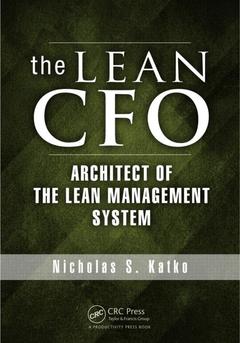The Lean CFO Architect of the Lean Management System
Auteur : Katko Nicholas S.

This book is not about debits, credits, or accounting theory. Instead, it describes how a chief financial officer (CFO) becomes a Lean CFO by leading a company in developing and deploying a Lean management system. The finance team, business executives, and Lean leaders will all benefit from its forward-thinking improvement approach.
Explaining why the CFO role is so critical for companies adopting a Lean business strategy, The Lean CFO: Architect of the Lean Management System illustrates the process of building and integrating a Lean management system into the overall Lean business strategy. It describes why CFOs should move their companies away from performance measures based on traditional manufacturing practices and into a Lean performance measurement system. In addition, it explains how to integrate a Lean management system with a Lean business strategy to drive financial success.
- Describes the logic behind why a Lean management system must replace a traditional management accounting system
- Discusses how flow can drive the financial success of Lean
The book explains why you must move your company into value stream accounting, which reports your internal financial information by the real profit centers of your business, your value streams. It describes the strategic aspects of making money from a Lean business strategy and also details how to modify your enterprise resource planning system to support Lean rather than hinder it.
The Architect. The Economics of Lean. $how Me the Value Stream Flow. $how Me the Office Flow. Measure Lean Performance, Not Profits. It’s about Spending, Not Costs. The Value of Measuring Capacity. Decisions, Decisions, Decisions. Standard Costing Debunked. Tame the ERP Beast. By the People, for the People.
After a tour of duty in public accounting, Nick Katko began his Lean management system career as chief financial officer of Bullard, a privately held manufacturing company in Kentucky. In the mid-1990s Bullard made a commitment to a Lean business strategy and began hiring operations people with Lean experience. Nick worked with Lean leaders to establish a comprehensive Lean performance measurement system that was used to measure and manage the entire business.
As inventory was dramatically reduced, Nick realized the irrelevance of the standard costing system to the business. Nick created and introduced value stream income statements to Bullard, and all business decision making was based upon a value stream financial analysis of decisions. Eventually, labor and overhead rates were set to zero and inventory valuation was made with a simple monthly journal entry capitalizing manufacturing costs.
In 2000, Nick left Bullard and started Strategic Financial Solutions, Inc., with his wife Deanna. Strategic Financial Solutions provides contract CFO and controller services as well as bookkeeping and tax services to companies in the Lexington, Kentucky area.
While on Bullard’s Lean journey, Nick read Making the Numbers Count by Brian Maskell. He liked the book so much he wrote Brian and told him about his own work with a Lean Management System. Nick and Brian talked regularly and, in 2002, Brian asked Nick to join BMA, Inc., as a senior consultant.
As a senior consultant with BMA, Nick uses his experience to assist clients in Lean management implementation by working closely with them to resolve the real-world issues they face in implementation. These issues include removing traditional cost-based performance measurement systems in favor of Lean performance measurement systems, migrating from a traditional income statement to a value stream costing income statement, creating a transaction elimination maturity path, and working with
Date de parution : 09-2013
15.6x23.4 cm
Disponible chez l'éditeur (délai d'approvisionnement : 13 jours).
Prix indicatif 46,39 €
Ajouter au panierThèmes de The Lean CFO :
Mots-clés :
Tr Ac; Cycle Time; business strategy; VA LU; performance measurement; Lean Operating; accounting; Lean Business Strategy; chief financial officer (CFO); NC IA; Lean Management; Total Cost; Single Piece Flow; value stream; Material Cost; Lean Companies; Lean Management System; ERP System; Business Process; Im Pr Ov Em; Ce Ll; Lean Practices; Stream Accounting; Box Score; Pe Ra Tio; Work Order; Standard Costing System; Predictable Cycle Times; Em Pl Oy Ee; Ar Ke Tin; Ra Te



